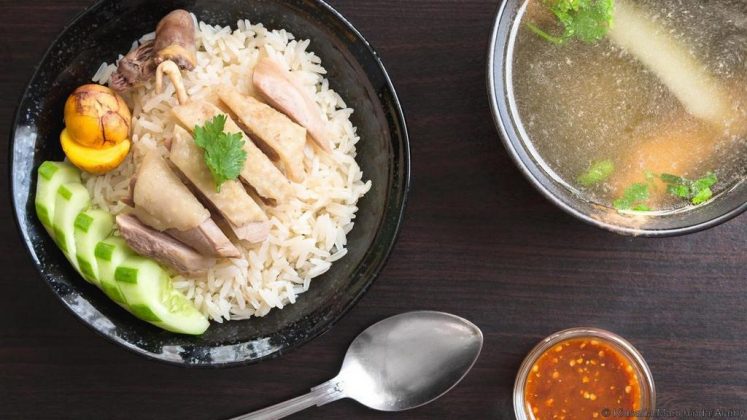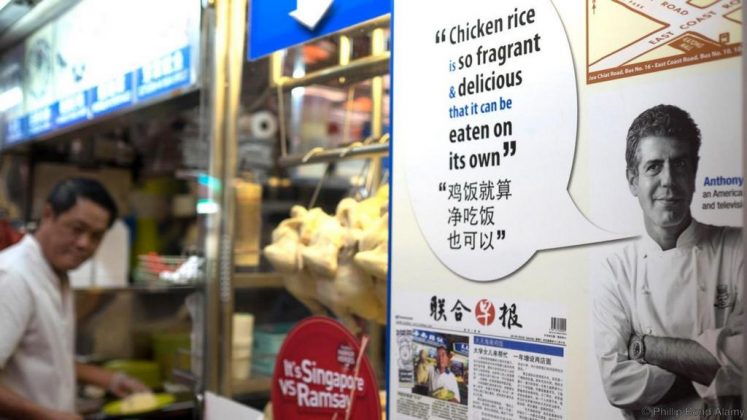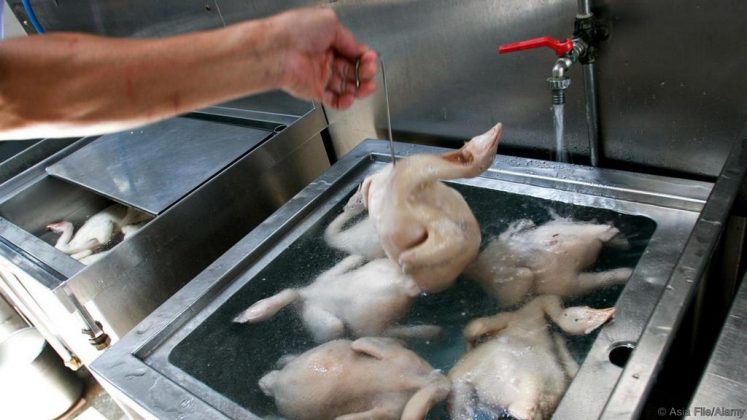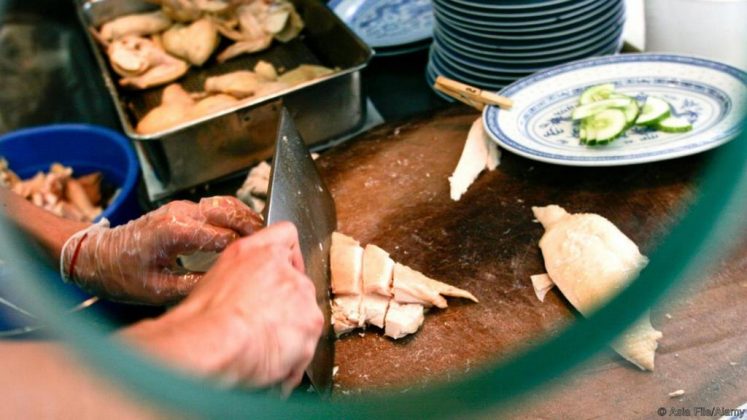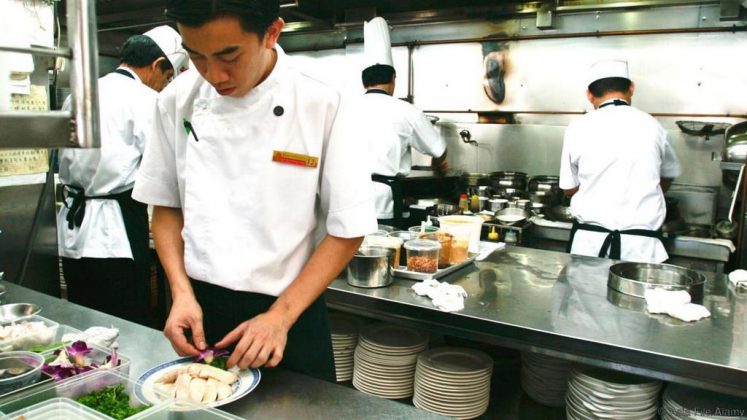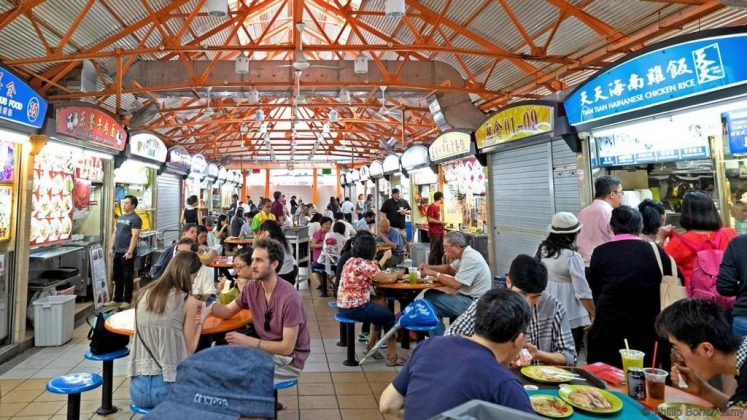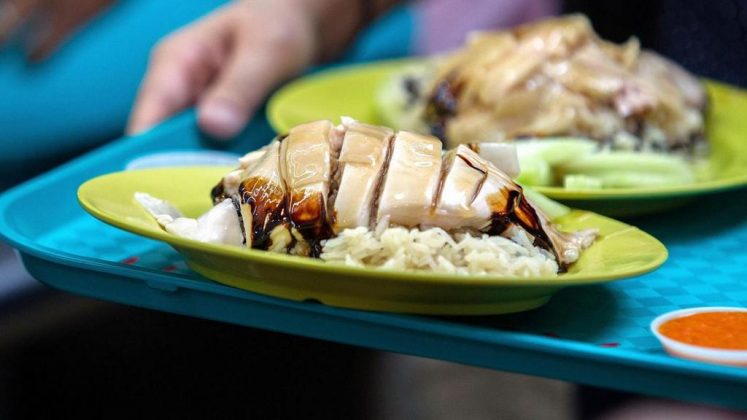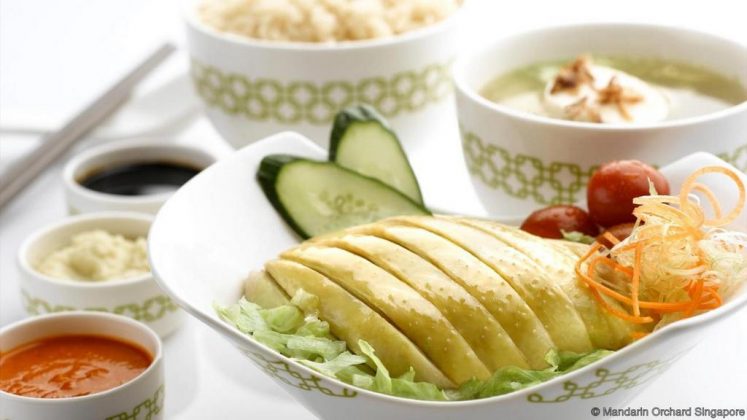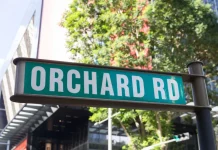Born out of frugality, Hainanese chicken rice – one of Singapore’s national dishes – may seem simple. But it’s the kind of dish you’d cross continents to eat.
- Top places to eat in Singapore — 5 must eat restaurants in Singapore
- What to eat in Singapore? — 10+ must-eat & best street food in Singapore
- Hong Kong Soya sauce Chicken Rice and Noodles — The first Singapore street food vendor ever awarded a honorable Michelin star
- Melaka food blog — Experience Melaka delicacies, arrived at by Trishaw
- Singapore best eats — 9+ best food to try in Singapore & food must eat in Singapore
Hainanese chicken rice is the chickeniest chicken dish one can find in the chicken-eating world. Don’t believe me? Picture this: sitting in front of me at the Maxwell Food Centre in Singapore’s Chinatown was a tray filled with a pile of boiled chicken, a mound of rice cooked in chicken broth and a small dipping bowl of chilli sauce infused with – yes, you guessed it – chicken. And just to out-chicken every other chicken dish on the planet, the ensemble included a bowl of chicken soup. I figured I’d probably be clucking by the end of the meal.
I specifically came to Maxwell to eat at 30-year-old food stall Tian Tian (1 Kadayanallur St), a spot renowned for its Hainanese chicken rice that has gotten praise from the likes of Anthony Bourdain and Gordon Ramsay. Just as I was about to shove spoonfuls of delicious-smelling food into my mouth, the owner, Madam Foo Kui Lian, wandered over.

She explained that Hainanese chicken rice, one of Singapore’s national dishes, is deceptively simple – which is good, because on paper it sounds awfully boring.
But you just have to try it when you’re in Singapore. I combined delicate pieces of chicken thigh – which had a thin layer of gelatinous fat between the skin and meat – with ginger-and-lemongrass-fragrant rice and chilli sauce, and then took a bite. The flavours set my taste buds ablaze with delight. You know when something is so good it’s sublime: when it hits your palate, you feel every molecule in your body jump and you can’t help but close your eyes and savour the moment. This was one of those moments.
Although I can find chicken rice back home in New York City, this version was the kind of transcendent dish I’d fly 15 hours just to eat. Despite its dull-seeming appearance and lack of colour, it was phenomenal. But, what perplexed me was why?

Let’s start with how it’s made. According to Madame Foo, you boil the chicken for about an hour. Then you plunge it into ice. “This traps the flavour in and also preserves the skin,” she said. After it sits in the ice for about 30 minutes, you hang dry it for half an hour. “Because the outside of the chicken is cold from the ice, the inside is still cooking.”
In the meantime, you take the leftover broth from cooking the chicken and use it to boil the rice, make the chicken soup and enhance the chilli sauce. The leftover chicken fat often ends up in a soy-sesame sauce that is slathered over the chicken before being plated. In total, the whole dish takes about two hours to complete.
But what makes Tian Tian so good – and so popular – among the myriad “food courts” sprinkled throughout this city-state? “It’s our secret sauce,” said Madam Foo, referring to the brownish liquid lightly poured over the chicken. I spooned some up from the bottom of the bowl. “Soy sauce, oyster sauce… and maybe chicken lard?” I said. Madame Foo just laughed and shook her head, not ready to reveal the ancient Singaporean secret just yet.
In my attempt to figure out just what makes this seemingly plain dish so abundantly delicious, I stopped at Chatterbox – an upscale eatery near posh Orchard Road that has continuously won awards for its Hainanese chicken rice – and sat down with chef Liew Tian Heong. At first glance, his chicken rice didn’t look too different than Tian Tian’s version, except that it was plated in expensive bowls – which led me to ask the chef what set it apart from the ultra-affordable, government-subsidised hawker centre versions, like at Maxwell Food Centre.
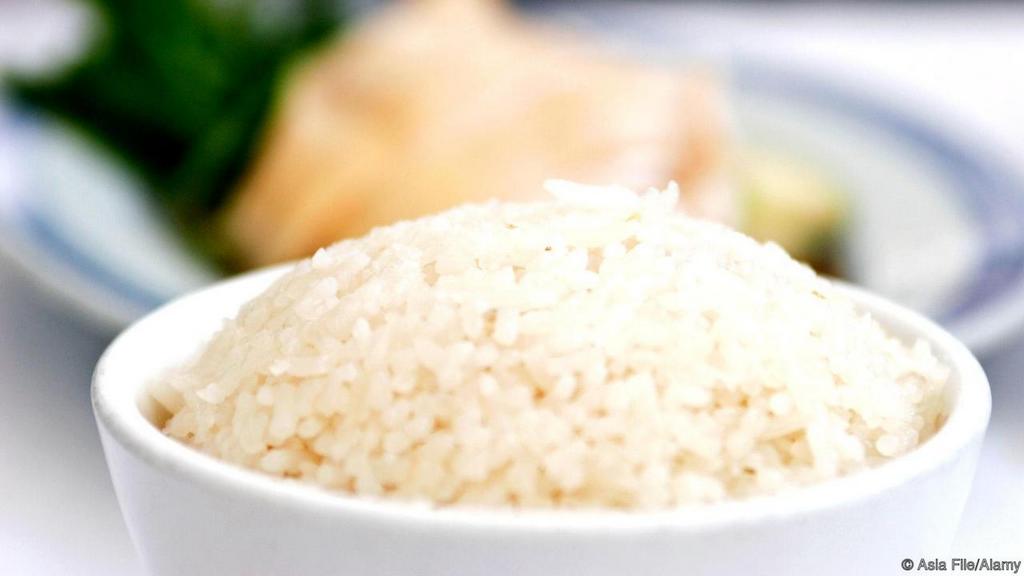
The aromatic rice is perhaps the most important part of the dish (Credit: Asia File/Alamy)
“The most important part of chicken rice,” Liew said, “is not the chicken, but the rice. It has to be fragrant.” He picked up the bowl of grains and gave it a whiff, his eyes closed as he savoured the smell. “Lemongrass, ginger, garlic and pandan leaf. The rice has to be good enough to eat on its own.”
The chicken rice at Chatterbox was excellent and exuded all the qualities of Tian Tian – even if it was four times more expensive. For the higher price you get a bigger portion, an elegant dining room, and, as Liew noted, their special breed of chicken from Malaysia. The fowl was softer and more tender than the others I’d tried, so maybe there’s something to having the luxury of your very own breed.
However, when considering its origins, there’s an irony to people forking over a lot of money or waiting in line for a quality version of Singapore’s national dish.
When the Hainanese people from the south Chinese island of Hainan began immigrating to Singapore around the middle of the 19th Century, they were marginalised because their dialect prevented them from fully communicating with other Chinese immigrants and because most of the lucrative industries were dominated by mainland Chinese who were already established in Singapore. This relegated them to being servants for the British colonialists or to working in the food service industry, which sometimes was the same thing. The Hainanese served the British chicken rice, thinking the seemingly non-exotic boiled chicken would be acceptable to their palates.
But the fact that the chicken flavour is so pervasive throughout the dish suggests something surprising. Liew explained it best: “People would use the old mother hen for chicken rice when she couldn’t lay any more eggs. And so they would make sure they got the most out of it by stretching out the flavour of the chicken – via the broth and the rice and so on – as much as possible.”
Chicken rice is a full meal born out of the frugality that comes with strife and a battle to survive, as the Hainanese struggled to establish themselves in Singapore.
And then everything began to change with the Japanese occupation of Singapore during World War II – when the British were forced out and the Hainanese people lost their source of income. This was when the first chicken rice restaurant opened. As local food blogger Tony Boey explained to me, “Before that, the Hainanese just prepared it in the home, but during and after the occupation, they were looking for new ways to make money.”
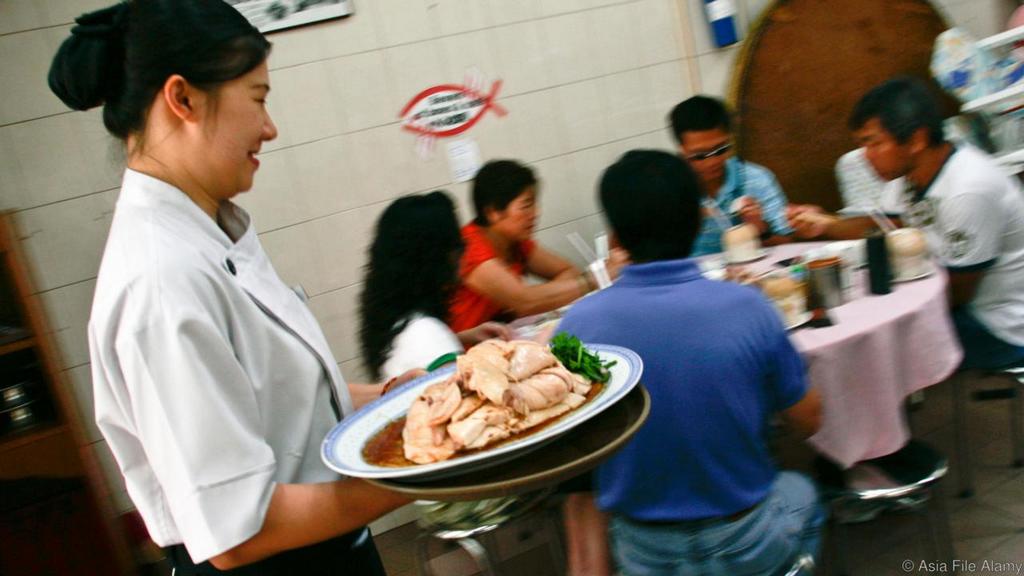
One of those early places to open was Yet Con (25 Purvis St), established in the early 1940s. It’s still there, serving up the same chicken rice.
I recruited a local chef friend, Vivian Pei, to accompany me there. When we walked in, around 5 pm, the owners gave us a dirty look. We were not only there between meals, but were there during their own dinner. They reluctantly allowed us to sit down.
And so here I was, sitting at one of a handful of marble tables scattered about the room. The no-frills mid-century ambience – with plain light-blue walls and a tiled floor – gave the restaurant an archaic feel.
When the chicken arrived at our table, something seemed strange. “There’s no sauce on the chicken,” said Pei.
Sometime in the 1970s or early 1980s, chicken rice cooks began drizzling the soy-sesame sauce on the cooked chicken. But Yet Con, apparently, still cooks up chicken like it’s 1949 – meaning sans sauce, giving the fowl an especially bland look.
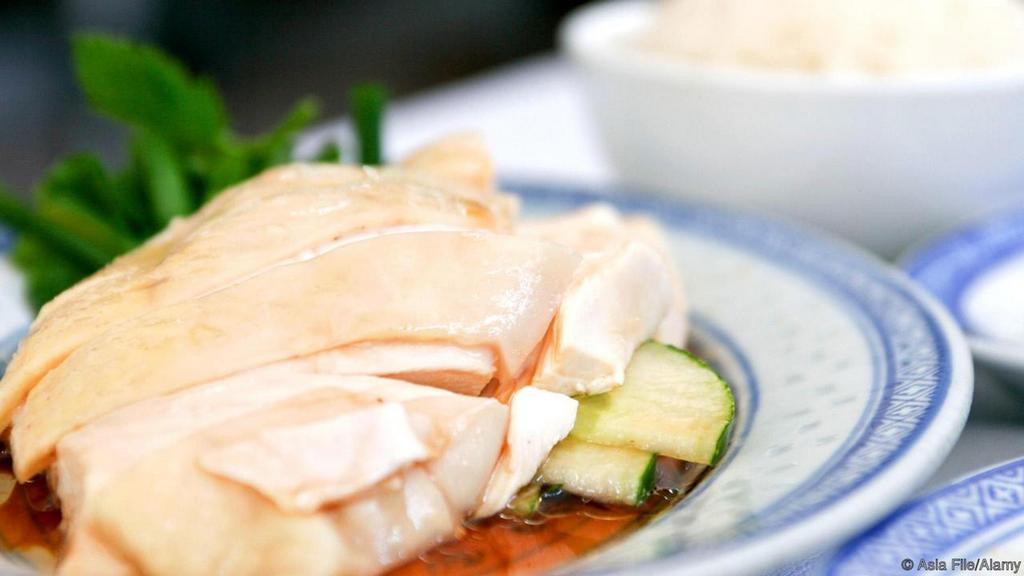
The other big difference, Pei pointed out, was that Yet Con lets the chicken dry naturally and eschews the whole ice-dipping technique. She took a bite. “It’s a bit dry.” Perhaps it wasn’t always viewed as dry, but as new techniques have evolved to make chicken more tender – such as dropping it in ice – this version seemed woefully behind the times.
“I think the key to excellent chicken rice,” Pei said, “is that everything must be balanced. If one thing is not good then it brings down the dish.” Like a chain is only as strong as its weakest link, chicken rice suffers if one element is mediocre. In the case of Yet Con, the “weak link” was the chicken itself.
It wasn’t the best way to end my week of eating chicken rice, but it didn’t matter. I said goodbye to Pei – she had a cooking class to teach and I had a few hours to kill before my flight – and I strolled in the direction of the airport. Before I hailed a cab, I savoured my remaining time in a city-state where a seemingly boring dish can – most of the times – be elevated into something so sapid and comforting that my memories of it alone will sustain me until my next visit.

See map of Hainanese chicken rice restaurants in Singapore at here.
Are you finding more top things to do in Singapore: Tours, activities, attractions and other things? Let’s check it out at here.
































![10 best airports in Asia in 2016 [RANKED] kuala-lumpur-international-airport-best airports in asia in 2016 by skytrax ratings](https://livingnomads.com/wp-content/uploads/2016/08/29/kuala-lumpur-international-airport-best-airports-in-asia-in-2016-by-skytrax-ratings-218x150.jpg)









